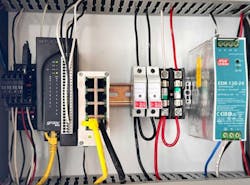PEP simplifies level measurement in saltwater processing tanks
June 20, 2024
3 min read
To prevent costly overflow spills and improve efficiency, Point Energy Partners in Fort Worth, Texas, has replaced manual and low-tech systems at its saltwater disposal (SWD) sites, which manage byproduct water laden with salts, hydrocarbons and industrial compounds from oil and gas production. PEP acquires and develops onshore oil and gas properties, presently in the Delaware Basin in West Texas and southeastern New Mexico, but it also operates midstream production assets, and runs a large water recycling program.
The SWD sites recently needed immediate attention because manual, onsite verification showed their flow-measurement systems were inaccurate, while their hydrostatic, head-level switches were obsolete and unreliable. These level switches were also part of an antiquated control process, which sought to maintain safe tanks levels by toggling transfer pumps based solely on current switch status or a manual override onsite. This outdated method didn’t allow remote oversight or control, and had no SCADA system. Plus, the SWD sites couldn’t spend much on upgrades, so regular process controls weren’t feasible. However, some remediation was essential because each overspill costs PEP about $200,000.
PEP decided to use radar level sensors, which employ microwave pulses and are non-contact, so they won’t corrode due to the salty wastewater in the tanks. Radar level sensors are also unaffected by changes in liquid density, temperature or pressure, and provide better precision and durability in harsh settings. To organize more and better data from its sensors, tanks and other SWD equipment, PEP also selected Inductive Automation’s web-based Ignition SCADA software, MQTT Sparkplug B interoperability protocol, and Ignition Perspective HMI for remote monitoring (Figure 1).
To give Sparkplug B a place to run, PEP also implemented Opto 22’s compatible groov RIO edge I/O because it was also flexible enough to turn on a contactor to run a pump, read an analog signal from the radar level sensors, or calculate flow from a pulse input generated by a turbine flowmeter. Plus, Sparkplug B’s payloads would allow groov RIOs to transmit real-time tank levels, flow rates and totals, add pump operating states to PEP’s SCADA system, and move data between it and SWD operations. For example, relay outputs could turn pump contactors on and off based on more accurate level readings from the radar level transmitters connected directly to groov RIO’s analog input channels. It also supported PEP’s many legacy pressure transmitters that use Modbus TCP protocol, and collect data that was previously stranded.
In addition, PEP is benefitting from groov RIO’s recent adoption of a CoDeSys runtime engine for further automating control functions, in its case, to automate pump control and tank level management, and eliminate overspills. PEP also uses Node-RED software running on RIO, which allows it to move data from physical I/O points, CoDeSys tags and Modbus/TCP sensors into OptoMMP registers, which are published to an Ignition-based MQTT broker.
“We only have one PLC programmer on our staff. He programmed CoDeSys, but our other five technicians found they could commissioning groov RIO themselves,” says Scott Adams, automation engineer at PEP. Out tech found that working in groov Manage and Node-RED was very accessible.”
This is part two of Control's June 2024 cover story mini-series. Read the other installments here.
About the Author
Sign up for our eNewsletters
Get the latest news and updates

Leaders relevant to this article:

